 This essay starts with a question "Is there a special property of hare's ear fur that is responsible for its long history in the construction of artificial trout flies?" A similar question was asked by Skues 100 years ago, and we still don't have a satisfactory answer.
This essay starts with a question "Is there a special property of hare's ear fur that is responsible for its long history in the construction of artificial trout flies?" A similar question was asked by Skues 100 years ago, and we still don't have a satisfactory answer.
 The essay then explores another fly that challenged the persistent influence of the Halfordian approach to fly-tying "It was the “Rackelhanen” that set me free from old traditions , made me innovative and allowed me to think differently." (Hans van Klinken 2017)
The essay then explores another fly that challenged the persistent influence of the Halfordian approach to fly-tying "It was the “Rackelhanen” that set me free from old traditions , made me innovative and allowed me to think differently." (Hans van Klinken 2017)
 In The Heuristic Trout there are repeated mentions of the inclusion of fur from the European hare, and snowshoe hare, in constructing effective trout flies. I have gathered them together in this essay which tries to understand the reason(s) responsible for their use down the ages.
In The Heuristic Trout there are repeated mentions of the inclusion of fur from the European hare, and snowshoe hare, in constructing effective trout flies. I have gathered them together in this essay which tries to understand the reason(s) responsible for their use down the ages.
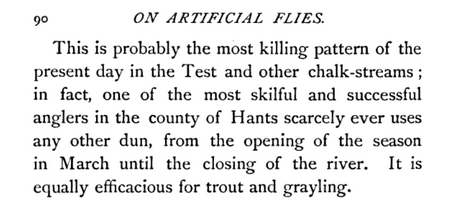 In Halford's time the Gold Ribbed Hare's Ear (GRHE) was, and continues to be, a very effective pattern. It doesn't look like any natural fly. Halford added wings to make it acceptable to dry fly purists, without any deterioration in its attractiveness to trout. In this comment from his 1886 book Halford recognized its effectiveness.
In Halford's time the Gold Ribbed Hare's Ear (GRHE) was, and continues to be, a very effective pattern. It doesn't look like any natural fly. Halford added wings to make it acceptable to dry fly purists, without any deterioration in its attractiveness to trout. In this comment from his 1886 book Halford recognized its effectiveness.
 Perhaps a little cruelly, Skues (1921 p91) wrote: At one time the late Mr. F.M. Halford was a great advocate of the Gold-ribbed Hare's Ear [GRHE], but I believe that latterly his enthusiasm for precise imitation induced him to give it up, successful pattern though he knew it to be, because he could not explain its success to his satisfaction.
Perhaps a little cruelly, Skues (1921 p91) wrote: At one time the late Mr. F.M. Halford was a great advocate of the Gold-ribbed Hare's Ear [GRHE], but I believe that latterly his enthusiasm for precise imitation induced him to give it up, successful pattern though he knew it to be, because he could not explain its success to his satisfaction.
 Was Skues being mischievous when he added: "Still, the Hare's Ear kills. And I should like to know who was the genius who first conceived its possibilities, and how he got at his theory. If we had that information progress might be possible " (Skues 1921 p91) [emphasis added].
Was Skues being mischievous when he added: "Still, the Hare's Ear kills. And I should like to know who was the genius who first conceived its possibilities, and how he got at his theory. If we had that information progress might be possible " (Skues 1921 p91) [emphasis added].
 Halford discarded the GRHE because it simply did not fit into his theory that dry-fly fishing required presenting a fly tied to imitate an identified floating dun. Gary La Fontaine recognised that the GRHE forecast Swisher and Richards' No-Hackle dry flies: ".. In a pique of intellectual integrity or foolhardy sophistry, depending on one's point of view, he abandoned the fly because this ancient no-hackle did not 'cock' like a proper dry fly." (La Fontaine 1990 p253)
Halford discarded the GRHE because it simply did not fit into his theory that dry-fly fishing required presenting a fly tied to imitate an identified floating dun. Gary La Fontaine recognised that the GRHE forecast Swisher and Richards' No-Hackle dry flies: ".. In a pique of intellectual integrity or foolhardy sophistry, depending on one's point of view, he abandoned the fly because this ancient no-hackle did not 'cock' like a proper dry fly." (La Fontaine 1990 p253)
 What was it that makes the Gold-Ribbed Hare's Ear (GRHE) such an effective artificial fly ?
It may be obvious, but the obvious is worth revisiting - the GRHE is the pinnacle of simplicity in artificial trout flies.
What was it that makes the Gold-Ribbed Hare's Ear (GRHE) such an effective artificial fly ?
It may be obvious, but the obvious is worth revisiting - the GRHE is the pinnacle of simplicity in artificial trout flies.


 Bob Wyatt uses hair from the hare's ear to create the body of his Deer Hair Sedge {pictured left} and Deer Hair Emerger [pictured right], flies which capture the essence of the Gold-Ribbed Hare's Ear - an effective dry fly abandoned by Halford, and adopted by Skues to represent a nymph.
Bob Wyatt uses hair from the hare's ear to create the body of his Deer Hair Sedge {pictured left} and Deer Hair Emerger [pictured right], flies which capture the essence of the Gold-Ribbed Hare's Ear - an effective dry fly abandoned by Halford, and adopted by Skues to represent a nymph.
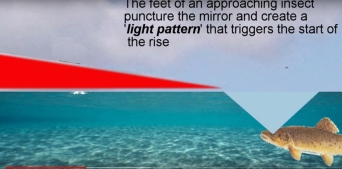 For an ethologist, the spiky body in these three flies is a good candidate for a sign stimulus that enables trout to capture insects on, or trapped in, the surface film because :
For an ethologist, the spiky body in these three flies is a good candidate for a sign stimulus that enables trout to capture insects on, or trapped in, the surface film because :
 This definition of 'flymph' - and how to present them - appears in an article written by Pete Hidy's son Lance Hidy (2018) who explains that his father made a clear distinction between flymphs, and other wet flies, but appreciated the similarities and differences between flymphs, and the nymphs tied by Skues.
This definition of 'flymph' - and how to present them - appears in an article written by Pete Hidy's son Lance Hidy (2018) who explains that his father made a clear distinction between flymphs, and other wet flies, but appreciated the similarities and differences between flymphs, and the nymphs tied by Skues.
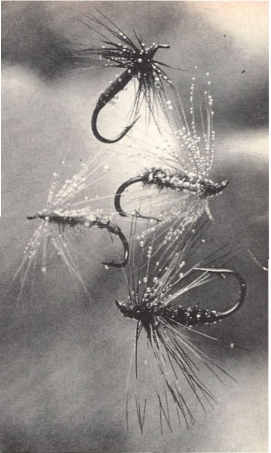 This photograph of flymphs in water shows bubbles of air covering their hackles and bodies. It was originally published in the American magazine Sports Illustrated in 1960 in the third of a three part series of articles by V.S. Hidy titled The Art of Wet Fly Fishing.
This photograph of flymphs in water shows bubbles of air covering their hackles and bodies. It was originally published in the American magazine Sports Illustrated in 1960 in the third of a three part series of articles by V.S. Hidy titled The Art of Wet Fly Fishing.

 The somewhat quaintly named website International Brotherhood of the Flymph contains a wealth of information including this collection of flies tied by Hidy that illustrate his use of hare's ear and tinsel to mimic the bubbles of air surrounding emerging insects - the transitional stage from nymph to dun.
The somewhat quaintly named website International Brotherhood of the Flymph contains a wealth of information including this collection of flies tied by Hidy that illustrate his use of hare's ear and tinsel to mimic the bubbles of air surrounding emerging insects - the transitional stage from nymph to dun.
 Lance Hidy (2018) pointed out that his father's pictures were possibly the first of their kind to be published in the fly-fishing literature.
Pete Hidy (1973) commented on this photograph: "the use of certain dubbings and hackles can create the phenomenon that I identify as mimicry because it goes beyond, but is related to, the quality of translucence" Hidy added mimicry to a list of features that convey life to an artificial fly: Undercolour, Translucence, Texture, Shape, Proportions, Delicacy, and Vitality, but acknowledged that the artificial only needed to incorporate one or two of these features: "as shown by the nymph imitations of two English anglers, Stewart and Kite".
Lance Hidy (2018) pointed out that his father's pictures were possibly the first of their kind to be published in the fly-fishing literature.
Pete Hidy (1973) commented on this photograph: "the use of certain dubbings and hackles can create the phenomenon that I identify as mimicry because it goes beyond, but is related to, the quality of translucence" Hidy added mimicry to a list of features that convey life to an artificial fly: Undercolour, Translucence, Texture, Shape, Proportions, Delicacy, and Vitality, but acknowledged that the artificial only needed to incorporate one or two of these features: "as shown by the nymph imitations of two English anglers, Stewart and Kite".
 In his 1979 article Hidy mentions how an angler should control the movement of a flymph; allowing unimpeded drift downstream with mending when there is a current, but adding movement in slow-moving water. It's worth reading Dave Hughes' (2015 p263-266) detailed description of what he calls Hidy's Subsurface Swing, based on his conversation with Hidy in the late 1970s. Two points emerge that are important in the present context - bubbles of air, and movement of the flymph:
In his 1979 article Hidy mentions how an angler should control the movement of a flymph; allowing unimpeded drift downstream with mending when there is a current, but adding movement in slow-moving water. It's worth reading Dave Hughes' (2015 p263-266) detailed description of what he calls Hidy's Subsurface Swing, based on his conversation with Hidy in the late 1970s. Two points emerge that are important in the present context - bubbles of air, and movement of the flymph:
 Trout live in an environment with a constant stream of inedible debris including bubbles. Therefore the question arises "How can bubbles act as sign stimuli to trigger a rise?". There are two possibilities:
Trout live in an environment with a constant stream of inedible debris including bubbles. Therefore the question arises "How can bubbles act as sign stimuli to trigger a rise?". There are two possibilities:

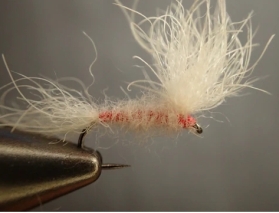

 The Rackelhanen was developed in 1967 by Kenneth Boström. It is constructed from just one material - polypropylene yarn.
The Rackelhanen was developed in 1967 by Kenneth Boström. It is constructed from just one material - polypropylene yarn.
 Perhaps unknowingly, Kenneth Boström had handed Hans van Klinken the key to a door that had been shut by Frederick Halford , and then locked by his followers, in the late 19th and early 20th century.
Perhaps unknowingly, Kenneth Boström had handed Hans van Klinken the key to a door that had been shut by Frederick Halford , and then locked by his followers, in the late 19th and early 20th century.
 Hans van Klinken's Klinkhåmer Special was the inspiration behind Bob Wyatt's Deer Hair Emerger [DHE]: "Unlike a high floating dry pattern, the trout notices a fly like a semi-sunk Klinkhamer Special or my own pet emerger, the DHE, [Deer Hair Emerger] from a greater distance and locks onto it. These flies share the strong triggers of a nymph and the hi visibility of a dry fly. The trout completes its behavioural response to a potential prey item by eating it. To a trout, charged up and in feeding mode, the fact that the fly doesn’t look exactly like the other bugs on the water is outweighed by its built-in behavioural releasers. " (Wyatt 2012). It is considered to be a multi purpose emerger pattern that works equally well on caddis and mayfly hatches (Rakkenes).
Hans van Klinken's Klinkhåmer Special was the inspiration behind Bob Wyatt's Deer Hair Emerger [DHE]: "Unlike a high floating dry pattern, the trout notices a fly like a semi-sunk Klinkhamer Special or my own pet emerger, the DHE, [Deer Hair Emerger] from a greater distance and locks onto it. These flies share the strong triggers of a nymph and the hi visibility of a dry fly. The trout completes its behavioural response to a potential prey item by eating it. To a trout, charged up and in feeding mode, the fact that the fly doesn’t look exactly like the other bugs on the water is outweighed by its built-in behavioural releasers. " (Wyatt 2012). It is considered to be a multi purpose emerger pattern that works equally well on caddis and mayfly hatches (Rakkenes).
 The underlying simplicity of many animal behaviours has been remarked upon by scientists and fly-fishers:
The underlying simplicity of many animal behaviours has been remarked upon by scientists and fly-fishers:
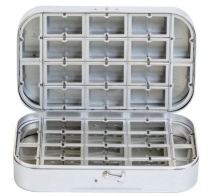 At its simplest, a theory is a way of explaining a group of related concepts and findings. It's a scientist's version of a fly box - a container with compartments for fly storage.
At its simplest, a theory is a way of explaining a group of related concepts and findings. It's a scientist's version of a fly box - a container with compartments for fly storage.
 More modern materials have overcome this limitation. Gary LaFontaine used Antron to mimic the air bubble on caddis pupae.
McGee's book Tying & Fishing Soft-Hackled Nymphs (2007) contains an in-depth description of suitable materials for tying flymphs, comments that "Synthetic dubbing doesn't absorb much water and is sometimes factory pre-treated with floatant, as such it's best used for flymphs or surface flies fished high in the water column". Synthetic materials can also be added to provide 'flash / sparkle' to hare's fur dubbing.
More modern materials have overcome this limitation. Gary LaFontaine used Antron to mimic the air bubble on caddis pupae.
McGee's book Tying & Fishing Soft-Hackled Nymphs (2007) contains an in-depth description of suitable materials for tying flymphs, comments that "Synthetic dubbing doesn't absorb much water and is sometimes factory pre-treated with floatant, as such it's best used for flymphs or surface flies fished high in the water column". Synthetic materials can also be added to provide 'flash / sparkle' to hare's fur dubbing.  Ed Engle (2017) makes a convincing case for the use of artificial materials: "Adding a little flash to a pattern is the most consistent 'trigger' that I have found."
Craig Mathews uses Z-lon for the tail in his Sparkle Dun that imitates the emerging insect's hydrofuge shuck.
Ed Engle (2017) makes a convincing case for the use of artificial materials: "Adding a little flash to a pattern is the most consistent 'trigger' that I have found."
Craig Mathews uses Z-lon for the tail in his Sparkle Dun that imitates the emerging insect's hydrofuge shuck.